Jade River: A History of the Mahurangi
Ronald H LockerFirst published 2001. Published online 2014–. This online edition is a work in progress…
Pages 39–45in printed edition
Mahurangi as missionary way-station
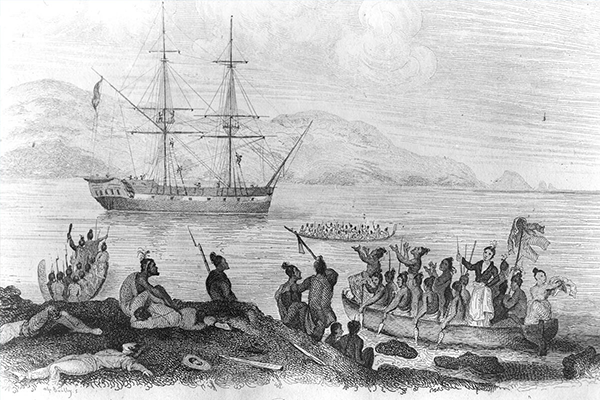
First Mission Vessel into the Bay and into the Gulf: Depicted making her first New Zealand landing, at owner Reverend Samuel Marsden’s initial mission at Rangihoua, Bay of Islands, on 22 December 1814, the brig Active, on 13 January 1815, bore Marsden, with Te Morenga of Taiāmai, to prospect the coast as far as the Firth of Thames. After 19 years, the brig Active was replaced by the handier schooner Columbine. Authentic images of the Active appear to be few, and sometimes she is depicted ship-rigged, with three masts. engraving unidentified
First missionary to enter the Hauraki Gulf was the pioneer of them all, Samuel Marsden, during his first visit in the brig Active, 1814–1815. Abounding in energy and curiosity, he explored to the mouth of the Waihou. According to his companion, Nicolas, theirs was only the fourth vessel to enter the gulf. Only five days were spent, and they passed Cape Rodneyas published 2001: Point Rodney in the dark, both ways. During a nine-month stay in 1820, he revisited the Firth of Thames on the Royal Navy spar shipas published 2001: spar ship. HMSS Coromandel is formally described as a store ship, but was deployed in Aotearoa, more specifically, to extract and transport spars Coromandel, and setting out in a whaleboat, gained the distinction of being the first European to explore the Waitematā. He returned via the Kaipara. Later that year, he travelled south from the Bay of Islands in a longboatas published 2001, colloquially: came down from the Bay in a whaleboat with Shepherd and Butler, camping on Kawau, and going on to explore the Manukau Harbouras published 2001: discover the Manukau.
Marsden had the good sense to put the devoted and capable Henry Williams in charge of the mission in 1823. He promptly established a new base at Paihia, from which he and his colleagues journeyed constantly down the coast, as far as the Bay of Plenty, braving storms in frail craft. Their energy was directed not only at finding and servicing bases for spreading the gospel, but also at keeping the peace in the charged atmosphere that prevailed as the legacy of the Musket Warsas published 2001: Hongi and his kin.
In these hazardous journeys, Mahurangi was a valued haven, especially in the period 1832–6, when Browne had his spar station there. The diaries of Williams are the best source for these visits, although the terser journals of William Fairburn make an interesting comparison, as the two were sometimes on the Mahurangi at the same time, either in company, or passing in opposite directions. There is constant reference to the capricious weather of the Hauraki Gulf and beyond, one thing that has not changed. It was a constant worry to these travellers in open longboats or small sailing vessels. But it must be remembered that Henry Williams was an experienced sailor, having served in the Royal Navyas published 2001: Navy through the Napoleonic Wars, and risen to lieutenant—he was on half-pay until entering holy orders in 1827.
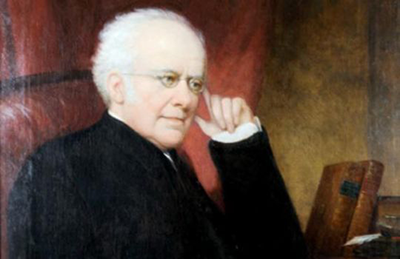
Schooner Man: Ex-Royal Navy Lieutenant Henry Williams was less than impressed by Marsden’s brig Active, and her vulnerability to a lee shore. By 1826, he’d had the 50-ton schooner Herald built, at Paihia, the first vessel of that scale built in Aotearoa. Ironically, the Herald saw little more than two years’ service, wrecked 6 May 1828, becalmed while attempting the challenging entrance to Hokianga Harbour. artist William Beetham
In 1833 Williams had a surprising request from the great warrior chief of Waikato, Te Waharoa, and was quick to respond. Fairburn’s diary records:
21 Mar 1833 Started from Te Purea in our whaleboat with Mr Shepherd in company in order to proceed to the Thames as the natives of that place are very desirous that a mission should be established amongst them. The open boat struggled down the coast facing bad weather, the MaoriMāori crew often exhausted after a day at the oars, and on 29th— arrived at Omaha, at 10 pm having pulled nearly 30 miles. We were all weary and glad to get on shore, where after having had prayers, we retired to our tent for the night.
30 Mar 1833 Proceeded towards Mahurangi and arrived within about six miles of the place in the evening, the wind and tide being against us. Hitherto we had not seen a living creature on any part of the coast since we left the BayBay of Islands, nothing to be seen but desertion and desolation. The day, I trust is about to dawn when these poor creatures shall return to their habitations and sit down in the knowledge of peace and righteousness.
31 Mar 1833 The morning set in with rain, after breakfast we had the native service, after which a sermon with singing and prayer by ourselves.
1 Apr 1833 Arrived at Mahurangi in the forenoon and found a ship called Nancy at anchor in the river, waiting to procure a load of timber for the Government. We dined on board, after which went on about four miles to PuhoiPūhoi having heard our old friend Rauroha was there—his party received us very friendly and seemed glad to see us. This chief, and his party, had come a distance of fifty miles in their canoe for the purpose of dragging timber out of the bush for the above-named vessel but had got tired and were now returning home.
2 Apr 1833 At sunrise this morning I was aroused by Samuel, who said that Messrs Williams and Chapman were passing by from Makitu. On ascertaining the fact thro the medium of a spy-glass, I followed them in the whaleboat and succeeded in overtaking them. We returned together to the place I had left and remained till the following day and were much gratified in thus meeting with each other and united in returning thanks to an almighty Being for all his mercies.
3 Apr 1833 Parted with Messrs Williams and Chapman, they on their way to the BayBay of Islands, and we arrived in the evening at Waiheke after passing thro a dangerous sea.
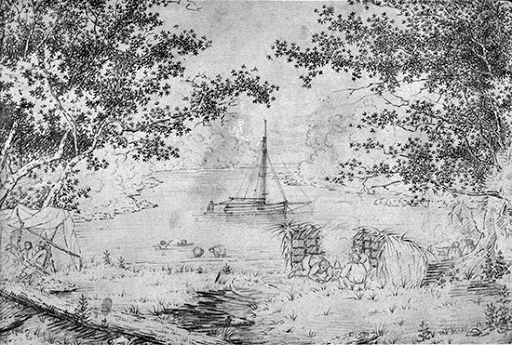
Henry’s Favourite Cove: Leigh Harbour had an early convert, in the person of missionary Henry Williams. For Pākehā mariner-missionaries at least, Leigh was the first shelter available in what they termed Mahurangi Bay, when en route from the Bay of Islands. from sketch by Henry Williams, 1831
Williams, who had been trying unsuccessfully to avert war between the Tauranga people and Ngāpuhi raiders under Tītore, records the meeting at Mahurangi thus:
1 Apr 1833 We proceeded on by the light of the moon which had now grown large and anchored our boats between Rangitoto and Motutapu. We lay down in the boats, not wishing to land, but the fleas were intolerable owing to the boys laying so close to me.
2 Apr 1833 Fine night. At 2 am we proceeded on our voyage as the tide had sufficiently flowed for us to pass between the islands. As we drew near Mahurangi we had to contend with considerable sea owing to the tide. To a person not experienced in boat sailing I consider this place dangerous, as from the strength of the tide a sea may be tossed up in a few minutes which would require great care and prudence to pass through [Whangaparāoa Passage]. As we approached the entrance of the river, we observed Mr Fairburn in our settlement boat coming towards us from a small river on our left. We were happy to learn that he with Mr Shepherd were on a visit here. We were thereby enabled to receive news from home of the welfare of our families and felt thankful to the Father of all mercies for his unspeakable care. Much refreshed after a good breakfast and a little putting to rights. Conversed with several natives here and some principal chiefs, Rauroha and Kupenga; they appeared much gratified at the prospect of any Missionaries coming into the neighbourhood. Great abundance of shark taken here in the season of a small kind, which forms an important article of food. [These Ngāti Pāoa rangatiraas published 2001: Ngati Pou chiefs claimed traditional fishing rights for these rich grounds].
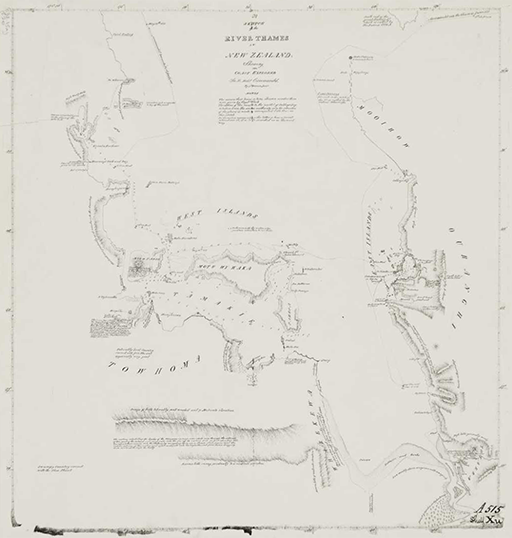
Purveying Christianity in Uncharted Waters: When Williams et al were initially traversing Mahurangi Bay, it was only partially charted, as reflected by Captain James Downie’s 1821 “Sketch of the Thames River”, which later appeared, more complete, titled, more respectfully, “Shouraka Gulf”. chart James Downie
3 Apr 1833 The night very cold and fine; wind had shifted and become fair for both parties. Messrs Shepherd and Fairburn took their departure for the Southd. and we for the Northd.; called in at Mahurangi to see Mr G. Brown who had commenced an establishment for timber etc. Ship Nancy here. Cap. Dacre kindly offered us any assistance we might stand in need of, but we had so husbanded our store of etceteras that we did not require any replenishing. Patuone hindered us for a long time in crying with Hamu our old lady who is a close relative of his. We went to see them in order to break up the assembly; they presented a shocking spectacle, so besmeared with blood we could not recognise any person. Took our departure about one o’clock, wind SSW and after rough sailing arrived at our favourite cove (Leigh) at dusk; took dinner and prepared for a continuation of our voyage during the night as the wind was fair, night fine and the moon full.
Patuone, formerly of the Hokianga, was brother to Waka Nene, son-in-law to Rauroha, and brother-in-law to Kupenga.
Fairburn and Shepherd explored far up the Waihou before returning. Their favourable report led to a second and larger exploratory expedition, comprising Williams and Brown in one longboat and Fairburn and Morgan in another, with the little open cutter Karere as tender. Williams describes the Cape Rodneyas published 2001: Rodney section of the voyage. After a day of rest at Leigh, replete with fish, pigeons and fernroot, they set out on a threatening morning:
25 Oct 1833 As we drew near the point of land going into the ThamesCape Rodney, the sea became irregular owing to the ebb tide and threatened to break on board, but we soon rounded and were immediately in smooth water. We continued on to Motu Kawau a large island, landed in a fine bay, perfectly secure from wind. We pitched our tents, brought everything ashore and prepared for a gale—by the assistance of a good fire at our tent doors we were very comfortable. No namus (sandflies) or moschettoes.
26 Oct 1833 At first dawn of day was awoke by the sound of these sweet bell birds, their varied notes filled the woods, and continue till sunrise , when they cease. Fine clear morning. but the wind strong from the SE. Could not move on our way. After breakfast we went to explore a river a little way from us. We found sufficient water and perfectly secure for any vessel, and a place which is highly important to know as a refuge in bad weather. Vast quantities of fine oysters growing to the rocks.
27 Oct 1833 Fine. Three missing boys returned in the night; they had lost themselves. We felt very thankful to see them.—At 10.30 assembled in a shady spot and held service—naught was heard but birds—as we sang the praise of God and our Redeemer, their voice was heard distinctly with ours, but I felt an indescribable something as I viewed the ground on which we sat. For many succeeeding years the neighbourhood hath been the seat of war in its most savage and infernal state; not content with killing, but even limb from limb—dividing asunder, and at times ere life has been extinct have they commenced the work of cannibalism—.
28 Oct 1833 After breakfast we crossed over to the South pt. of the Island to take bearings of the various islands points etc. around us. Considerable difficulty in ascending the hills owing to the fern and shrubs etc. with which it is covered; however our view was good, and I was enabled to take a sketch of the Islands and country around. Eveng. fine; more wind from the Westd.; launched the boats and put every thing on board except our beds, in prospect of an early move.
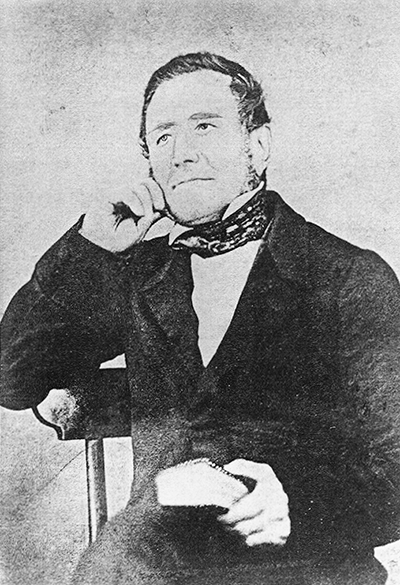
Where a Fairer Fairburn than William Walked: Many of William Fairburn’s great-grandson Rex Fairburn’s journeys would also be by open boat, but from the considerably closer Devonport. He was want to motor north at night, lying on a mattress, steering by the stars and with his feet, to be discovered sleeping in the lounge of bibliophile Terry Bond’s self-built house, snugged into Huawai Bay. William Fairburn’s abortive 83 000-acre Maraetai mission “Fairburn purchase”, as altruistic as its intent may have been, stands in deep contrast to the scant property aspirations of his Walking on My Feet, Great Depression-poet descendant. image Fairburn archive
29 Oct 1833 Cloudy and symptoms of strong wind. Determined to make the attempt to cross; shipped some water as we drew into the tide way, but the boys pulled well into Mahurangi by ¼ past eight. Landed in a quiet bay to breakfast. After assembling our boys to morng. service, we proceeded up the harbour to see Mr G. D. BrownGordon Davis Browne. We found him well and living in perfect quietness with about 30 of his natives; he gave us much information and furnished us with a more correct chart of this part of the Thames. We left this beautiful place about 3 for WangaparauaWhangaparāoa, and passed over in 1¼ hour; the wind was strong but we passed on comfortably; we were some time finding a place where to land and pitch our tents, as the coast was very forbidding and stony.—
Fairburn wasted fewer words on this journey:
25 Oct 1833 At 3 am started with a fair wind but a gale coming on was obliged to go on shore on an island named Ko te Kawau about 6 miles short of Mahurangi.
26 Oct 1833 Not being able to proceed on account of a strong south wind we went in the boat a few miles up an interesting river which we found had been thickly inhabited by the Ngatiwatua tribe. Alarmed in the evening by two of our Natives missing, they returned at midnight.
27 Oct 1833 We had regular service with the Natives and they were addressed by Mr Williams; in the evening assembled as usual, the wind still blew strong in the same quarter.
28 Oct 1833 Still unable to proceed; we therefore crossed the bay in which we were, and ascended an opposite hill for the purpose of a sketch being taken by Mr Williams of the different Islands, bays, rivers etc.
29 Oct 1833 Started early in the morning and arrived at Mahurangi; afterwards proceeded on to Wangaparaua where we remained for the night, a most forbidding place, nothing but rocks and quite open to the sea.
On the return voyage they were holed-up for two days between Motutapu and Rangitoto, whose awesome landscape so impressed Williams that he devoted a page of his diary to describing it.
30 Nov 1833 —we concluded the wind would die away in the evening. At 9 pm left this place; but little wind. Crossed comfortably by midnight to Wangaparaoa.
Fine night. At 3 entered Mahurangi; discovered it with difficulty; lit fires and lay down to take some rest. At 7 proceeded to Mr G. D. Brown. We did not remain long there. At 2 arrived at Omaha. Wind south. No Karere here. Took a hurried dinner and continued our course toward home. We entered Wangamata (Mangawhai) at dusk. The breakers were running in an ugly way at the mouth of the river, but the flood tide soon carried us in—We felt thankful we were thus far on our way; 59 miles since 9 last evening.
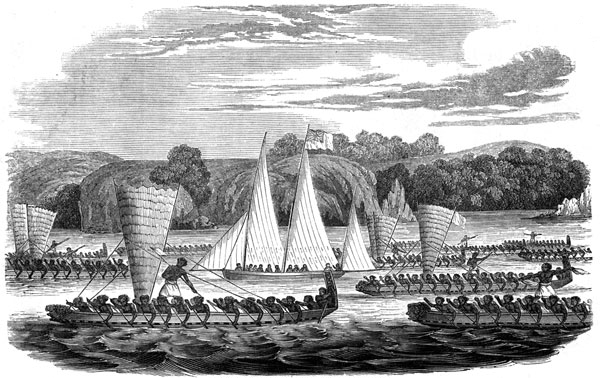
Elusive Columbine: A reliable image of what former Royal Navy lieutenant Henry Williams refers to as the “fine little craft”, the Columbine, has proved elusive. The earlier Gilbert Mair-build mission craft, the undecked schooner-yawl Karere depicted here voyaging southward with Ngāpuhi, with the aim of averting warfare when the waka taua reach Tauranga, must suffice. Meantime, it is conceivable that Williams named his Gilbert Mair-built schooner for Lieutenant Edward Columbine, commander of hms Resolution… wood engraving after Henry Williams sketch
Fairburn’s account of this exhausting stage was laconic indeed:
28 Nov 1833 At nine o’clock this evening the wind having abated we proceeded to Mahurangi.
29 Nov 1833 Arrived at Mangawai.
In 1835, Williams set out to visit Tāmaki in the Columbine. He had just purchased the little schooner from Gilbert Mair and was clearly delighted with his purchase, which spelt the end of travel in whaleboats. He set out, noting:
11 Feb 1835 My birthday, a good day to commence a Missry. tour upon.
15 Feb 1835 Hazy morning. More to windward than we expected, a fine little craft. Mahurangi a little to windward. About 10 o’clock came to anchor in this beautiful place. Capn. Brown sent off a note to request that we would go on shore and hold service. We landed about 11 o’clock and soon assembled a very comfortable congregation, in all twelve. The Captain and his brother (G.D.B.) were very friendly. Held native service at 3, and in the evening returned on board.
16 Feb 1835 As the wind was still from the Southd. we could not move till high water. Went on shore to breakfast with our friends. Cap. B. has a very great interest in Missions; he wanted much to commence a school here but had not the means and we could not help him out. At 10 weighed and worked out, continued working to windward till dusk. Much pleased and surprised at the sailing qualities of our little vessel. At sunset dirty appearance. Brought up for the night.
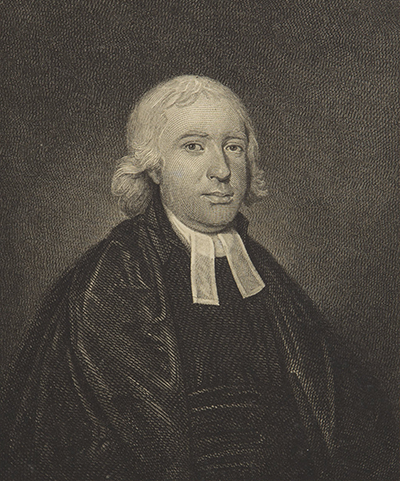
Irish-Flogging Pro-Māori Parson: By today’s standards, the opinion of many missionaries towards their potential flock was appalling. Labelled by detractors as the “flogging parson”, when his role as New South Wales principal chaplain also included magistrate, Samuel Marsden’s views of indigenous Australians were as benighted as his of indigenous New Zealanders were enlightened; his of his appointee Thomas Kendall were another matter. engraving James Fittler
The party was resting at Tāmaki, after crossing the portage and canoeing extensively on the Manukau, when Williams made an impulse decision to return to Mahurangi:
28 Feb 1835 Some natives from the Bay of Islands had passed and communicated that a party of natives in 4 canoes from Wangari under Kahakaha and Motutara, were prowling about for the purpose of surprising any small party. My spirit was cast down within me. We felt a strong disposition to go in quest of them.—
1 Mar 1835 Strong wind from S.S.E. and cloudy. Concluded to run for Mahurangi as we lay in rather an exposed place, and to learn the truth of the report—We accordingly weighed and made sail. About 9 o’clock the rain came on so thick we could scarcely see the land close to us and it was now blowing a perfect gale. At noon the weather cleared a little and showed us our desired haven. We soon came to anchor and were glad to find refuge from the gale. The weather was too severe to go on shore. In the evening held a pleasant service in the cabin.
2 Mar 1835 A heavy night blowing and raining hard, decks leaky in several places. The weather cleared at daylight to our great relief. Called on Capn. Brown. The wind being yet much strong I remained on shore during the afternoon. Capn. B is much intererested in missions and a member of the Madras Committee. I spent a very agreeable time with him. I here learned the particulars of the expedition which had put in here: they are between 40 and 50 but impudent mischievous fellows. [The reference is to the Madras Committee of the Church Missionary Society. Presumably Captain Brown had been an officer in the Indian Army.]
3 Mar 1835 At daylight weighed and made sail to our Island where we had left the boat. Much distressed at the conduct of the natives—.
So ends William’s accounts of calls at Mahurangi.
The first description of the Mahurangi with any detail comes from another missionary of that time, the Reverend William Yate. An Account of New Zealand records his experiences as a servant of the Church Mission Society, 1828–34. He returned to England on the spar ship hmss Buffalo, and was on board when she loaded in Mahurangi in January 1834. He was a very keen observer:
The entrance to the frithvariant of firth used consistently by Yate of the Thames is rendered dangerous, in a few instances, by small rocks showing themselves a few feet above the surface of the water, and not readily distinguished at night. The Bay of Mahurangiomitted from the 2001 editions, the opening sentence of this paragraph is important in establishing the Yate begins by describing an area that commences, in the north, with Leigh Harbour—“Bay of Mahurangi”. The officers of the Buffalo name Mahurangi Harbour Kaihow on their chart, although a later iteration bears the name Maurhangi Harbour, on the western side of the Firth, is deep; has several rivers running into it; is studded with several small islands; and has a fine harbour, named by the natives of the place, Kaihu. This harbour, which is situated at the head of the bay, is well protected from all winds and from the sea; and affords a secure anchorage, and is easy of access. The depth of water is sufficient, to the distance of three miles, for any description of ships: the only caution necessary is, to keep all projecting points at a distance of about a hundred yards, and to avoid the reefs which extend from them, particularly the rock at its entrance. The southern or largest passage, formed by an island and the main, is the safest and best, having in it ten fathoms’ water: the northern, or smallest passage is full of rocks, the channel narrow, and has only two and a half fathoms of water. Fresh water for shipping is not easily to be obtained; as it can only be procured from the river several miles from the anchorage. The latitude of the anchorage is 36 28’56″ south; longitude, 174 46’38″ east of Greenwich. The tide flows ten feet at springs; and the time of high water is ten o’clock, full and change. The several rivers emptying themselves into the Bay of Mahurangi are navigable only for canoes and boats. A small harbourLeigh Harbour, fit for cutters and small craft, is situated on the northern side of the island forming the bay.
With the exception of the Bay of Islands, none of these ports are generally known, as no charts or descriptions of them have hitherto been published. A few Europeans, expressly trading to some of them, are the only civilized people perfectly acquainted with them. All the ports abound in fish and oysters.
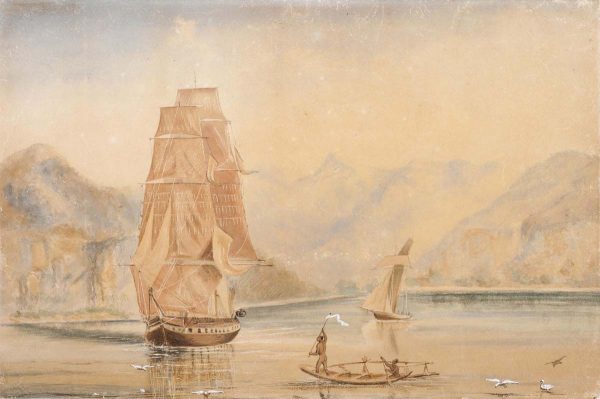
16-Carronade 2-Bow-Chaser Backup: Bishop Selwyn’s 22-ton topsail schooner Undine depicted by the artist and commander of her 485-ton escort, Royal Navy sloop-ship Fly, in what was Dillons Bay, Erromango, Vanuatu. The bay was renamed in 2009 for the missionary John Williams, eaten there 10 years prior to this 1849 visit, along with fellow missionary James Harris. Also named for John Williams were five mission ships, all funded by school-children subscription. artist Captain Richard Aldworth Oliver, 1850
Yate had clearly accompanied the mate in the ship’s boat during Cudlip’s hydrographic survey.
Another clerical visit belongs to the next decade. Georgeas published 2001: Bishop Selwyn, like Henry Williams, was an accomplished and daring sailor, taking his 22-ton Niccoll-built topsail schooneras published 2001: tiny Undine as far afield as New Caledonia, ferrying pupils of his college. By 1847, Bishop Selwynas published 2001: he was making pastoral visits to Kawau. Writing from the Undine at the Kawau Copper Mine, he said of his local congregation:
27 May 1847 This community adds much to the pleasure of my thoughts, for instead of a reckless and godless band of drunkards, the great body of the labouring people are sober, and well-disposed to religion. On my first visit, though their rush huts were streaming with water over the mud floors, nearly forty children assembled to school in as neat attire as could be seen in any village in England. The congregation at divine service was nearly one hundred, all apparently attentive and devout. As you may suppose it is a mixed community of all religious persuasions, and sometimes a Wesleyan preaches, and sometimes a local preacher. and sometimes myself. But I make a rule to ask no questions, and assume all to be Churchmen till they declare their unwillingness to listen to me, which is never the case. Tomorrow (Whitsun-Day) I hope to hold two services with them, and superintend, or rather assist at, the distribution of prizes to the school children.
26 Oct 1848 I am closing this letter on board the Undine, now lying in the little harbour of Mahurangi, and waiting for a storm to pass away, that we may go to spend the Sunday at the copper mine (already mentioned) on the Island of Kawau.
The bishop used a cove at Kawau to lay up his schooner and repair her after a grounding on the coral. Writing to his wife, he described the tranquillity of the place, and wished she was there.
The indefatigable bishop was even more famous for his treks on foot. By this means, he made his first pastoral visits to the Mahurangi in the 1860s. His route was the rather notional Great North Road, which led over Moirs Hill, where he used to enjoy the hospitality of the Chaplin family’s isolated homestead. The family had taken up a bush block near Ahuroa. One day when Mrs Chaplin was at the washtub, she heard movement in the scrub. A man appeared, clad in old clothes, scragged by bush lawyertātarāmoa, Rubus cissoides. Endemic, hooked vine, and wearing a wide-brimmed, flat-crowned hat. He enquired whether there were any children to baptise. Thinking he was an itinerant Catholic priest, she said:
I don’t think Captain Tuohy will let you baptise his, he belongs to the Church of England.
…came the reply:
So do I, I’m the bishop.
The word went around; seven bairns were gathered in and baptised. Selwyn stayed for dinner and went on his way. A droll memory, from a different source, may be part of the same tale. The bishop emerged from the bush and enquired if there were any Episcopalians about:
Don’t know about that, but the dog bailed up something in the bush the other day.
Such visits predate records of the Warkworth church, but it is said that he stayed with Henry Palmer, flour miller, on his visits to the town.
A local correspondent reported one such occasion, probably the last of his ministry in New Zealand:
His Lordship the Bishop of New Zealand arrived here from the north on Saturday, and on Sunday held services in the morning in the Public Hall, and in the afternoon at the Weslyan Chapel. On both occasions his Lordship delivered eloquent and impressive addresses.
Weekly News 9 March 1867
None of the cloth ever took pastoral visits more seriously or ecumenically.
